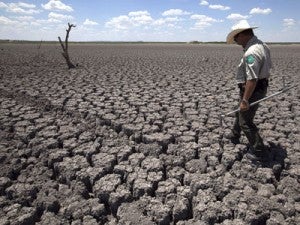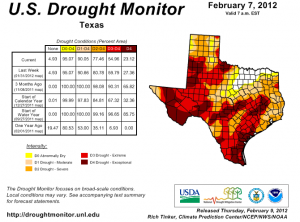
This commentary was originally posted on EDF’s Texas Clean Air Matters blog.
The Texas Legislature is back in session, and there will be, as always, a lot of discussion about how to fund schools. The school system in our state seems to be chronically short of funds to meet the demands of our growing state and its children.
But while the state-level politicians discuss, some school districts are taking matters into their own hands where they can. In the summer 2012, the Houston Independent School District (HISD), the seventh largest school district in the U.S. and the state’s largest, hosted a student through the EDF Climate Corps program. The program trains graduate students to find energy savings in their host institutions or companies. The Climate Corps fellow at HISD found several potential projects to help save the district money. For example, HISD has approximately 1,000 temporary buildings. The fellow found that if all the trailer-type temporary buildings’ lighting and wall air conditioning units and box heaters were upgraded and had insulation installed, at an upfront cost of $453,000, the district would realize over $62,000 in annual savings, nearly 700 kilowatt hours in annual electricity savings, and an annual reduction of approximately 400 metric tons of carbon dioxide. And that’s just one project!
The student’s work built on the findings of an audit funded through the State Energy Conservation Office (SECO) in 2007, which estimated that with recommended upgrades, HISD could cut its annual energy costs by $15 million!
Since the 2007 audit was performed, Houston voters have approved two bonds to help upgrade their school district, including one in November 2012. In the last bond vote, they approved, by a margin of nearly 2:1, a $1.89 billion bond to replace and repair 40 schools in HISD. In recent years, HISD has committed to ensuring all new and future buildings meet Leadership in Energy and Environment Design (LEED) standards for green building.
In 2009, the Texas Legislature passed Senate Bill 300, which was signed by Governor Perry. It requires school districts to develop long-term energy plans. It leaves it up to the boards of trustees of the individual school districts to determine if they want to submit the plan to SECO to help finance measures for plan compliance. There is no way to determine which school districts have developed plans or are implementing them. This Legislature could require school districts to report to SECO or could establish some minimum standards for building new school facilities or renovating existing ones.
Nationwide, schools spend more than $6 billion on energy costs, and the US Department of Energy National Renewable Energy Lab estimates that most schools could save about 25 percent of that by implementing smart energy measures. Those savings could pay 40 million new textbooks, 30,000 new teachers or 1.5 million new computers every year.
Some relatively simple measures such as daylighting (using windows and skylights to bring in natural light) have a double benefit—in addition to saving the average middle school tens of thousands of dollars in energy costs, daylighting technologies are also proven to improve students’ academic performance. One study in North Carolina showed that students who attended daylight schools scored up to 14 percent better on tests than the equivalent non- daylight school students. Smarter energy technologies and conservation measures lead to lower electricity costs, but also to lower maintenance costs, better indoor air quality, and free up money that can be used on other necessities, such as hiring teachers or buying more computers.
There is often an upfront cost to installing these energy efficiency technologies (although many conservation measures, such as turning off vending machine lights require no cost and only save money), but in most cases, school districts are in a good position to take advantage of several financing options. SECO operates the LoanSTAR program, which uses a revolving loan mechanism to fund energy efficiency projects for public buildings, including those in school districts. SECO also operates the Texas Cool Schools grant program, which helps Texas schools lower their operating costs by purchasing new and more energy-efficient heating, ventilation and air conditioning (HVAC) systems.
Performance contracting is another way to finance upfront costs for schools. Under performance contracts, contractors pay the upfront costs, which are recouped through a portion of the resulting savings, and even guarantee net savings for the building owner.
As we start this new Legislative Session in Texas, and parallel debates happen about our impending energy crunch and how to fund schools, doesn’t it make sense to merge these two issues? Help our school districts reduce energy costs (and in the process improve indoor air quality, student performance, and water efficiency) and enable them to spend their money on improving education, and reduce stress on the grid. Don’t the schoolchildren of Texas deserve that?
 As part of my role at EDF, I keep track of stories about the benefits of energy efficiency. By that, I don’t just mean data and figures, rather stories about the real, tangible and positive impacts saving energy can have on everyday people. We live in a data-driven world, especially those of us who work on energy and climate issues, but it’s the stories about people that really stay with us. In the past few months, I’ve noticed a quite a few stories from local papers around the country discussing the benefits that schools have seen from implementing customer, or demand-side, solutions – such as energy efficiency, on-site renewables, like rooftop solar, and demand response (DR) initiatives – which allow customers to voluntarily reduce their high electricity use and receive a payment for doing so in the process.
As part of my role at EDF, I keep track of stories about the benefits of energy efficiency. By that, I don’t just mean data and figures, rather stories about the real, tangible and positive impacts saving energy can have on everyday people. We live in a data-driven world, especially those of us who work on energy and climate issues, but it’s the stories about people that really stay with us. In the past few months, I’ve noticed a quite a few stories from local papers around the country discussing the benefits that schools have seen from implementing customer, or demand-side, solutions – such as energy efficiency, on-site renewables, like rooftop solar, and demand response (DR) initiatives – which allow customers to voluntarily reduce their high electricity use and receive a payment for doing so in the process.













